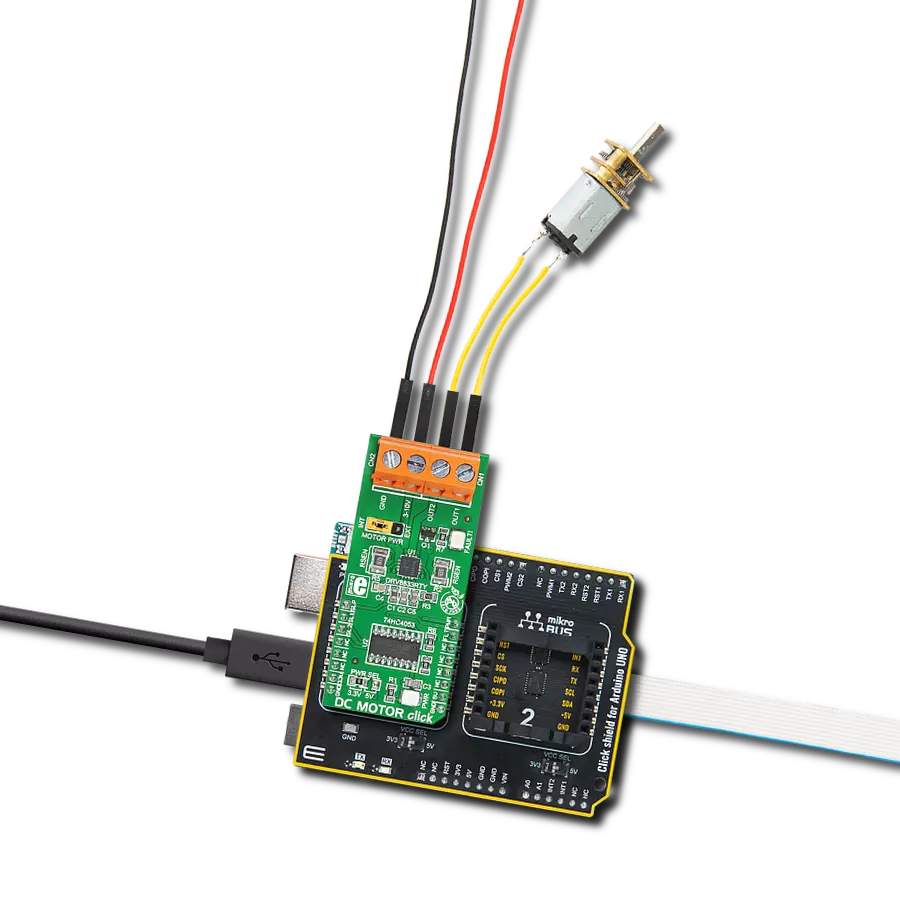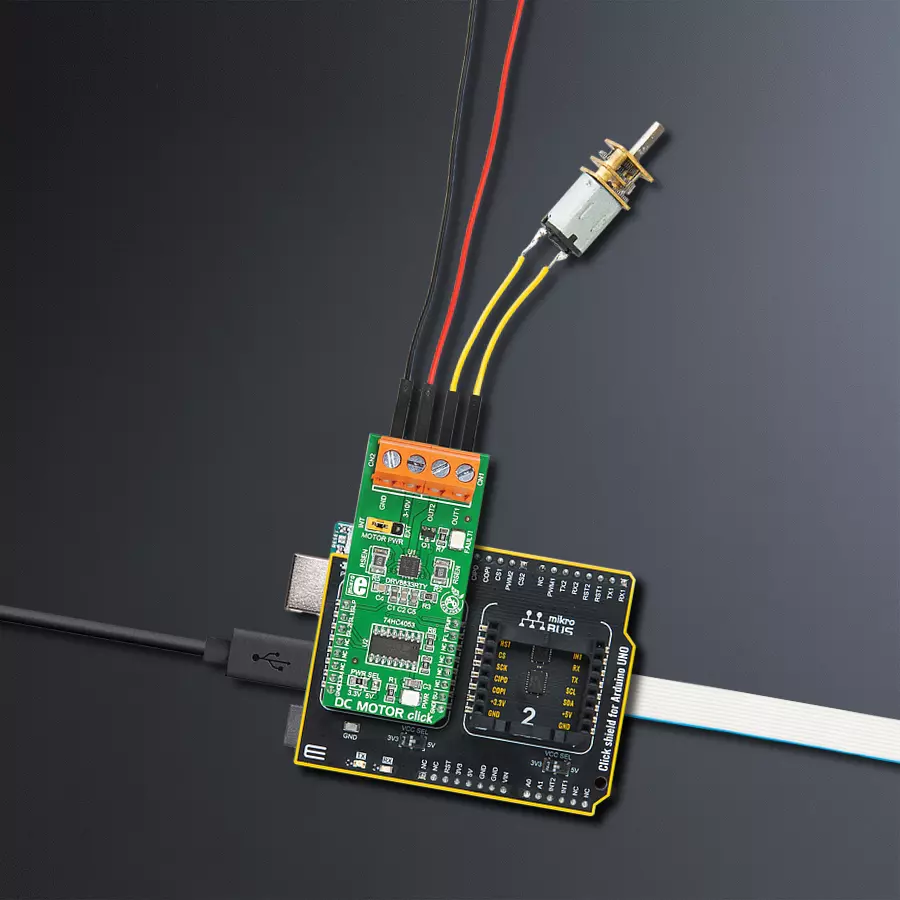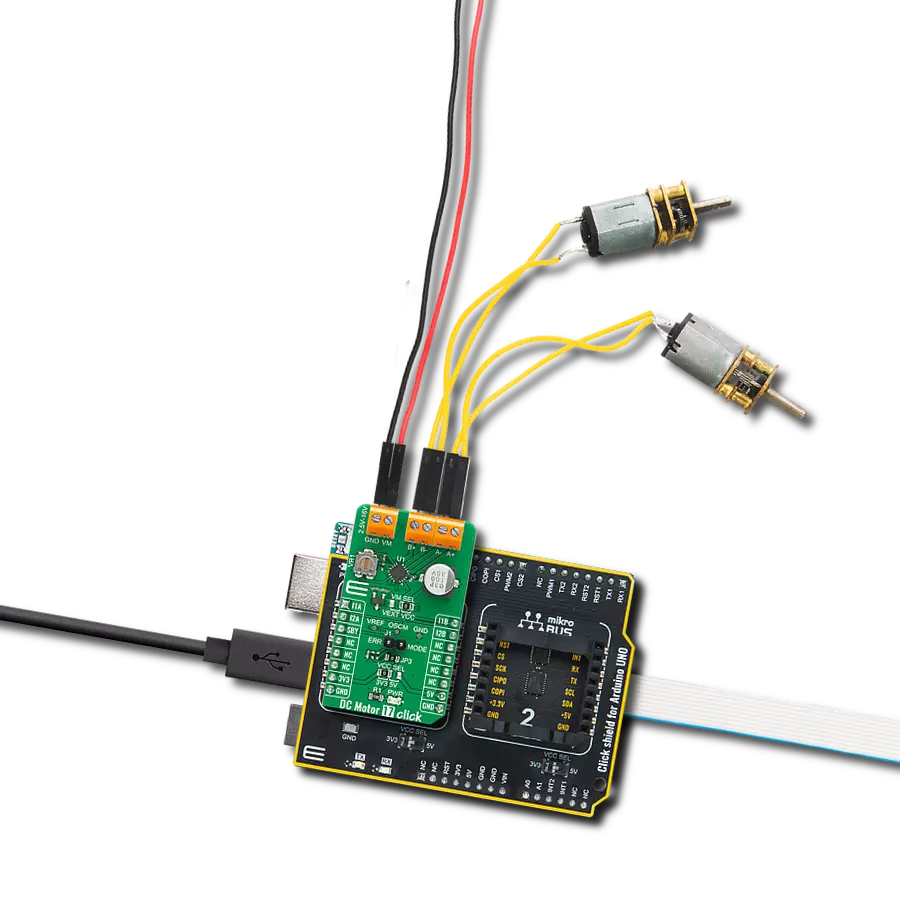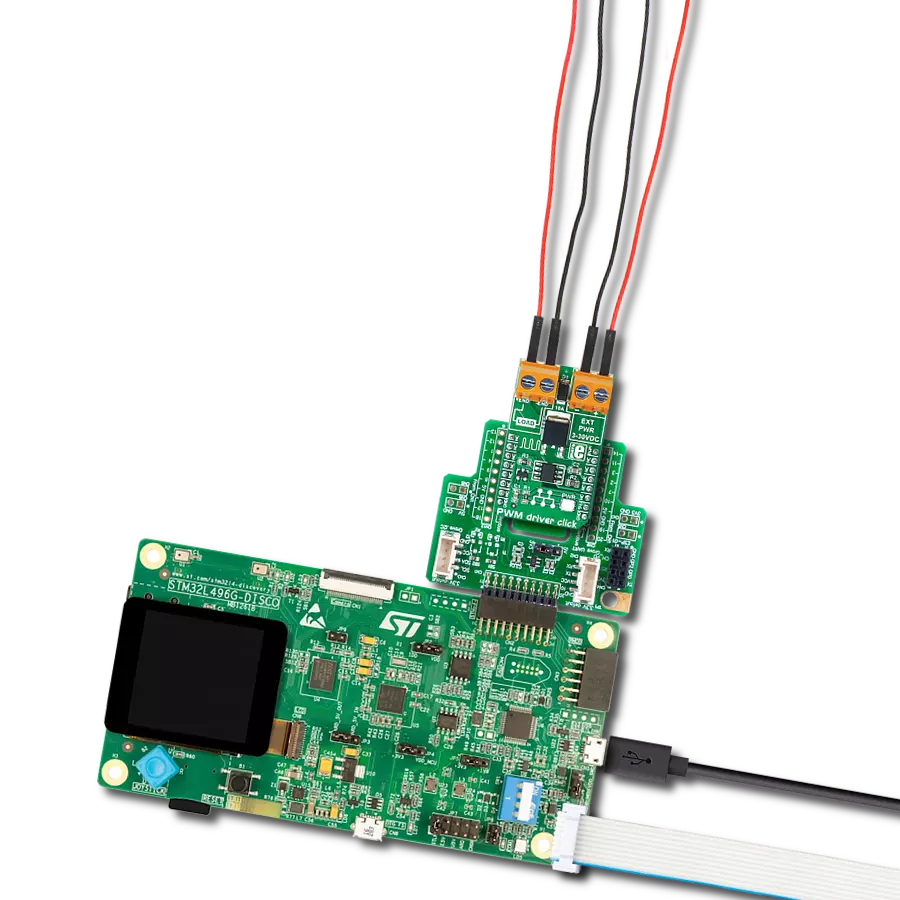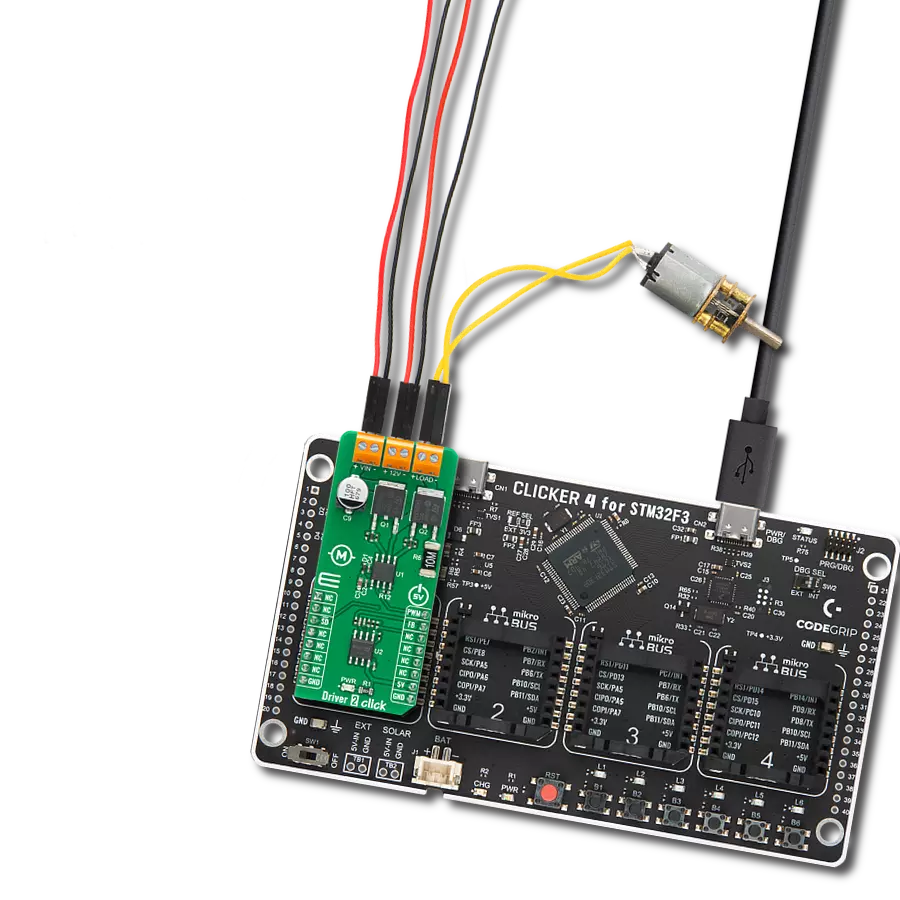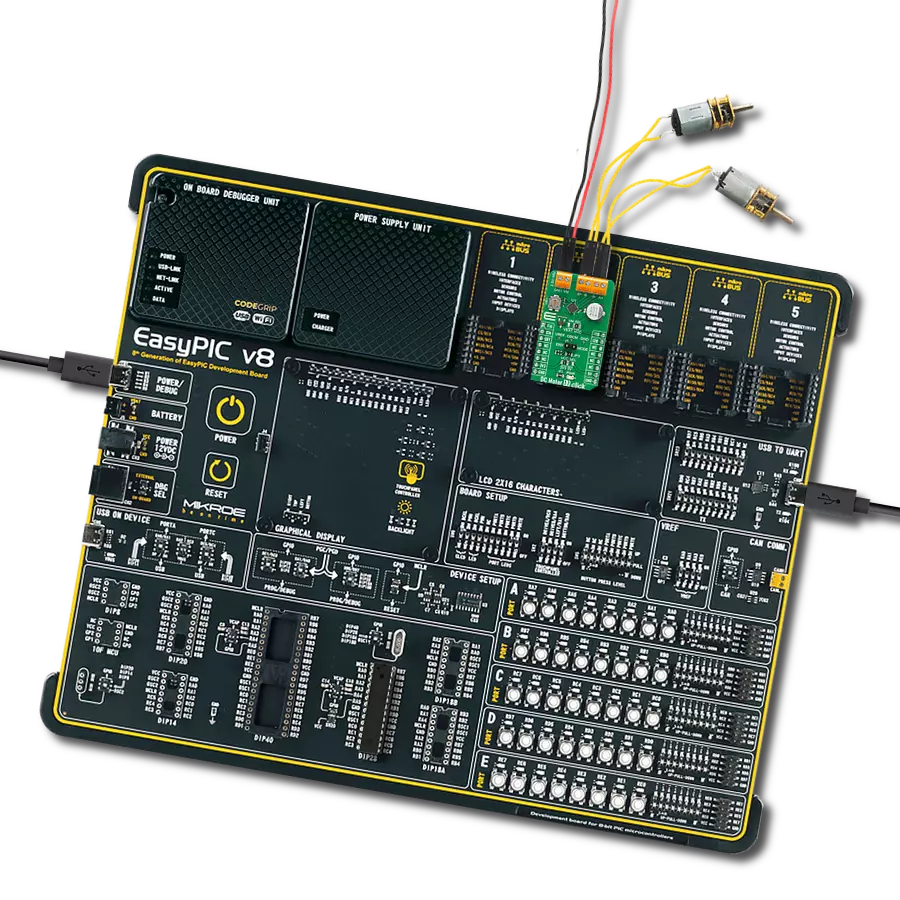Compact, user-friendly solution for controlling brushed DC motors with minimal fuss and maximum reliability
A
A
Hardware Overview
How does it work?
DC MOTOR Click is based on the DRV8833, an H-bridge motor driver with current-control PWM circuitry from Texas Instruments. The DRV8833 has two integrated H-bridges connected in parallel for double the current of a single H-bridge rated for an operating voltage range from 3V to 10V. The output driver block of the DRV8833 consists of N-channel power MOSFETs configured as an H-bridge to drive the motor windings, where each H-bridge includes circuitry to regulate or limit the winding current. Thanks to the current sense resistors R2 and R5 of 220mΩ, the driving current is limited to 0.9A. In addition, the 74HC4053 is also incorporated into the design to run the motor with only one PWM line from the mikroBUS™ socket. Thanks to this multiplexer, in combination with the selection pins
SL1 and SL2, routed to the RST and CS pins of the mikroBUS™ socket, control of the DRV8833 driver as well as management of its operating modes (Coast/Fast Decay, Reverse, Forward, Brake/Slow Decay) is enabled. This mux can also be used for PWM control of the motor speed. The DRV8833 also has a complete set of diagnostic and protection capabilities that support robust and reliable operation, like over-current protection, short circuit protection, undervoltage lockout, and overtemperature. In any case, the user can also visually detect them, in addition to the FLT pin, through the red LED marked with FAULT. It is also possible to set the driver in low-power Sleep mode via the SLP pin routed to the AN pin of the mikroBUS™ socket. In this state, the H-bridges are
disabled, the gate drive charge pump is stopped, all internal logic is reset, and all internal clocks are stopped. This Click board™ can operate with both 3.3V and 5V logic voltage levels selected via the PWR SEL jumper. It allows both 3.3V and 5V capable MCUs to use the communication lines properly. Additionally, there is a possibility for the DRV8833 power supply selection via jumper labeled as MOTOR PWR to supply the DRV8833 from an external power supply terminal from 3V to 10V or from mikroBUS™ power rails. However, the Click board™ comes equipped with a library containing easy-to-use functions and an example code that can be used, as a reference, for further development.
Features overview
Development board
Arduino UNO is a versatile microcontroller board built around the ATmega328P chip. It offers extensive connectivity options for various projects, featuring 14 digital input/output pins, six of which are PWM-capable, along with six analog inputs. Its core components include a 16MHz ceramic resonator, a USB connection, a power jack, an
ICSP header, and a reset button, providing everything necessary to power and program the board. The Uno is ready to go, whether connected to a computer via USB or powered by an AC-to-DC adapter or battery. As the first USB Arduino board, it serves as the benchmark for the Arduino platform, with "Uno" symbolizing its status as the
first in a series. This name choice, meaning "one" in Italian, commemorates the launch of Arduino Software (IDE) 1.0. Initially introduced alongside version 1.0 of the Arduino Software (IDE), the Uno has since become the foundational model for subsequent Arduino releases, embodying the platform's evolution.
Microcontroller Overview
MCU Card / MCU
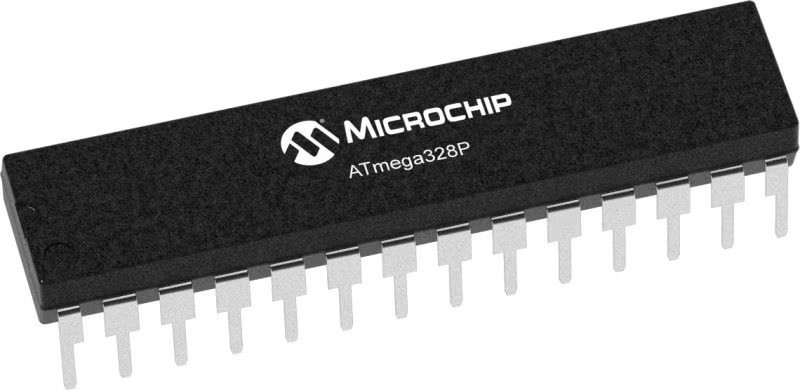
Architecture
AVR
MCU Memory (KB)
32
Silicon Vendor
Microchip
Pin count
28
RAM (Bytes)
2048
You complete me!
Accessories
Click Shield for Arduino UNO has two proprietary mikroBUS™ sockets, allowing all the Click board™ devices to be interfaced with the Arduino UNO board without effort. The Arduino Uno, a microcontroller board based on the ATmega328P, provides an affordable and flexible way for users to try out new concepts and build prototypes with the ATmega328P microcontroller from various combinations of performance, power consumption, and features. The Arduino Uno has 14 digital input/output pins (of which six can be used as PWM outputs), six analog inputs, a 16 MHz ceramic resonator (CSTCE16M0V53-R0), a USB connection, a power jack, an ICSP header, and reset button. Most of the ATmega328P microcontroller pins are brought to the IO pins on the left and right edge of the board, which are then connected to two existing mikroBUS™ sockets. This Click Shield also has several switches that perform functions such as selecting the logic levels of analog signals on mikroBUS™ sockets and selecting logic voltage levels of the mikroBUS™ sockets themselves. Besides, the user is offered the possibility of using any Click board™ with the help of existing bidirectional level-shifting voltage translators, regardless of whether the Click board™ operates at a 3.3V or 5V logic voltage level. Once you connect the Arduino UNO board with our Click Shield for Arduino UNO, you can access hundreds of Click boards™, working with 3.3V or 5V logic voltage levels.
DC Gear Motor - 430RPM (3-6V) represents an all-in-one combination of a motor and gearbox, where the addition of gear leads to a reduction of motor speed while increasing the torque output. This gear motor has a spur gearbox, making it a highly reliable solution for applications with lower torque and speed requirements. The most critical parameters for gear motors are speed, torque, and efficiency, which are, in this case, 520RPM with no load and 430RPM at maximum efficiency, alongside a current of 60mA and a torque of 50g.cm. Rated for a 3-6V operational voltage range and clockwise/counterclockwise rotation direction, this motor represents an excellent solution for many functions initially performed by brushed DC motors in robotics, medical equipment, electric door locks, and much more.
Used MCU Pins
mikroBUS™ mapper
Take a closer look
Click board™ Schematic

Step by step
Project assembly
Track your results in real time
Application Output
1. Application Output - In Debug mode, the 'Application Output' window enables real-time data monitoring, offering direct insight into execution results. Ensure proper data display by configuring the environment correctly using the provided tutorial.

2. UART Terminal - Use the UART Terminal to monitor data transmission via a USB to UART converter, allowing direct communication between the Click board™ and your development system. Configure the baud rate and other serial settings according to your project's requirements to ensure proper functionality. For step-by-step setup instructions, refer to the provided tutorial.

3. Plot Output - The Plot feature offers a powerful way to visualize real-time sensor data, enabling trend analysis, debugging, and comparison of multiple data points. To set it up correctly, follow the provided tutorial, which includes a step-by-step example of using the Plot feature to display Click board™ readings. To use the Plot feature in your code, use the function: plot(*insert_graph_name*, variable_name);. This is a general format, and it is up to the user to replace 'insert_graph_name' with the actual graph name and 'variable_name' with the parameter to be displayed.

Software Support
Library Description
This library contains API for DC MOTOR Click driver.
Key functions:
dcmotor_pwm_start- Start PWM module.dcmotor_enable- Enable the motor function.dcmotor_sleep_mode- Set sleep mode function.
Open Source
Code example
The complete application code and a ready-to-use project are available through the NECTO Studio Package Manager for direct installation in the NECTO Studio. The application code can also be found on the MIKROE GitHub account.
/*!
* \file
* \brief DcMotor Click example
*
* # Description
* This application change the speed and direction of DC Motor.
*
* The demo application is composed of two sections :
*
* ## Application Init
* Initialization driver enable's - GPIO,
* PWM initialization, set PWM duty cycle and PWM frequency, enable the motor, start PWM and start write log.
*
* ## Application Task
* This is a example which demonstrates the use of DC Motor Click board.
* DC Motor Click communicates with register via PWM interface.
* It shows moving in the left direction from slow to fast speed
* and from fast to slow speed.
* Results are being sent to the Usart Terminal where you can track their changes.
*
* \author Nikola Peric
*
*/
// ------------------------------------------------------------------- INCLUDES
#include "board.h"
#include "log.h"
#include "dcmotor.h"
// ------------------------------------------------------------------ VARIABLES
static dcmotor_t dcmotor;
static log_t logger;
uint8_t dcmotor_direction = 1;
void application_init ( void )
{
log_cfg_t log_cfg;
dcmotor_cfg_t cfg;
/**
* Logger initialization.
* Default baud rate: 115200
* Default log level: LOG_LEVEL_DEBUG
* @note If USB_UART_RX and USB_UART_TX
* are defined as HAL_PIN_NC, you will
* need to define them manually for log to work.
* See @b LOG_MAP_USB_UART macro definition for detailed explanation.
*/
LOG_MAP_USB_UART( log_cfg );
log_init( &logger, &log_cfg );
log_info( &logger, "---- Application Init ----" );
// Click initialization.
dcmotor_cfg_setup( &cfg );
DCMOTOR_MAP_MIKROBUS( cfg, MIKROBUS_1 );
dcmotor_init( &dcmotor, &cfg );
log_printf( &logger, " Initialization PWM \r\n" );
dcmotor_set_duty_cycle ( &dcmotor, 0.0 );
dcmotor_pwm_start( &dcmotor );
log_printf( &logger, "---------------------\r\n" );
}
void application_task ( )
{
static int8_t duty_cnt = 1;
static int8_t duty_inc = 1;
float duty = duty_cnt / 10.0;
if ( dcmotor_direction == 1 )
{
dcmotor_sleep_mode ( &dcmotor );
dcmotor_right_direction_slow ( &dcmotor );
log_printf( &logger, "> CLOCKWISE <\r\n" );
dcmotor_enable ( &dcmotor );
}
else
{
dcmotor_sleep_mode ( &dcmotor );
dcmotor_left_direction_slow ( &dcmotor );
log_printf( &logger, "> COUNTER CLOCKWISE <\r\n" );
dcmotor_enable ( &dcmotor );
}
dcmotor_set_duty_cycle ( &dcmotor, duty );
Delay_ms ( 500 );
if ( 10 == duty_cnt )
{
duty_inc = -1;
if ( dcmotor_direction == 1 )
{
dcmotor_direction = 0;
}
else if ( dcmotor_direction == 0 )
{
dcmotor_direction = 1;
}
}
else if ( 0 == duty_cnt )
{
duty_inc = 1;
}
duty_cnt += duty_inc;
}
int main ( void )
{
/* Do not remove this line or clock might not be set correctly. */
#ifdef PREINIT_SUPPORTED
preinit();
#endif
application_init( );
for ( ; ; )
{
application_task( );
}
return 0;
}
// ------------------------------------------------------------------------ END
Additional Support
Resources
Category:Brushed
